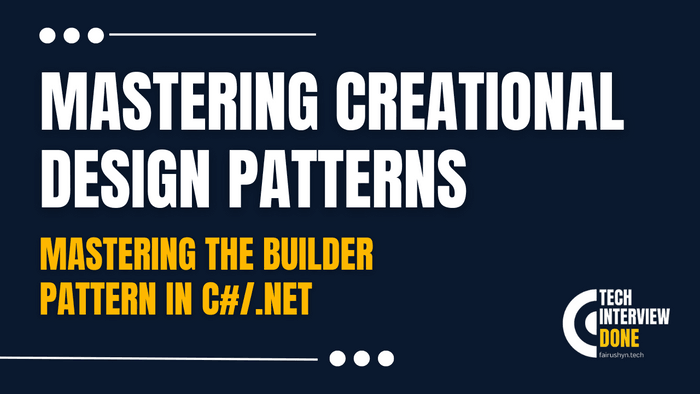Mastering the Builder Pattern in C#/.Net
A Deep Dive for Software Engineers
3 min read · — #design-patterns#creational-patterns#builder
Introduction
Embarking on the journey of understanding design patterns, especially in the context of C#/.Net, can significantly enhance a software engineer's ability to design flexible and maintainable code. Among these, the Builder pattern shines as a beacon for scenarios where complexity calls for elegance. This post aims to unravel the intricacies of the Builder pattern, providing you with a robust understanding and actionable insights into its application. Whether you're refining your architectural expertise or preparing to ace technical interviews, mastering the Builder pattern will add a valuable tool to your software development arsenal. Let’s dive deep into the realm of creational design patterns, focusing on the Builder, to uncover its potential in solving real-world software design challenges.
Understanding the Builder Pattern
The Builder pattern is a creational design pattern that aims to separate the construction of a complex object from its representation. This allows the same construction process to create different representations. It's particularly useful when an object needs to be initialized with a number of parameters, some of which might be optional. This pattern comes in handy to avoid a constructor with many parameters, which can be confusing and prone to errors.
Core Components of the Builder Pattern:
- Builder: This interface declares product construction steps that are common to all types of builders.
- Concrete Builder: Implements the Builder interface and provides specific implementations of the building steps. It has the ability to return the final product.
- Director: Responsible for executing the building steps in a particular sequence to construct the product. However, it works with the builder interface, which allows for the construction of products with different implementations.
- Product: The final object that results from the construction process.
Real-World Scenario: Building a Customizable Meal
Imagine you are tasked with designing a system for a restaurant that allows customers to create their own meals by choosing a variety of options for each course. The meal could consist of different components like a starter, main course, drink, and dessert. Each of these components can have several variations.
Step 1: Define the Product
First, define the product that the builder will construct. In this scenario, our product is a Meal.
public class Meal
{
public string Starter { get; set; }
public string MainCourse { get; set; }
public string Drink { get; set; }
public string Dessert { get; set; }
public override string ToString()
{
return $"Starter: {Starter}, Main Course: {MainCourse}, Drink: {Drink}, Dessert: {Dessert}";
}
}Step 2: Create the Builder Interface
The IMealBuilder interface declares the steps necessary to build a meal.
public interface IMealBuilder
{
void BuildStarter(string starter);
void BuildMainCourse(string mainCourse);
void BuildDrink(string drink);
void BuildDessert(string dessert);
Meal GetMeal();
}Step 3: Implement the Concrete Builder
The ConcreteMealBuilder class implements the IMealBuilder interface, providing specific implementations for the
building steps.
public class ConcreteMealBuilder : IMealBuilder
{
private Meal _meal = new Meal();
public void BuildStarter(string starter)
{
_meal.Starter = starter;
}
public void BuildMainCourse(string mainCourse)
{
_meal.MainCourse = mainCourse;
}
public void BuildDrink(string drink)
{
_meal.Drink = drink;
}
public void BuildDessert(string dessert)
{
_meal.Dessert = dessert;
}
public Meal GetMeal()
{
return _meal;
}
}Step 4: The Director
The MealDirector class can take an IMealBuilder instance and use it to create different types of meals by executing
the building steps in a particular sequence.
public class MealDirector
{
public void MakeMeal(IMealBuilder builder)
{
builder.BuildStarter("Soup");
builder.BuildMainCourse("Steak");
builder.BuildDrink("Wine");
builder.BuildDessert("Cheesecake");
}
}Using the Builder Pattern
Now, let's use the Builder pattern to create a meal.
var builder = new ConcreteMealBuilder();
var director = new MealDirector();
director.MakeMeal(builder);
var meal = builder.GetMeal();
Console.WriteLine(meal.ToString());This approach simplifies object creation, making the code more readable and maintainable. It also encapsulates the construction logic, allowing for flexibility in creating various representations of the product.
Conclusion
The Builder pattern offers a sophisticated way to deal with complex object creation, providing clarity and flexibility. By understanding and applying this
pattern, software engineers can significantly improve the design and architecture of their applications. It's a powerful tool in your design pattern toolkit, especially valuable in scenarios where objects need to be created with different combinations of configuration options. Embrace the Builder pattern to craft your solutions with precision and elegance, paving the way for scalable and maintainable codebases.
